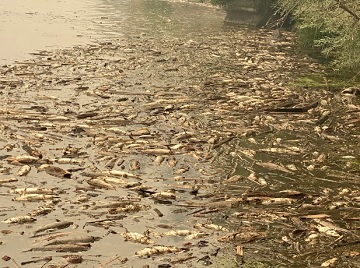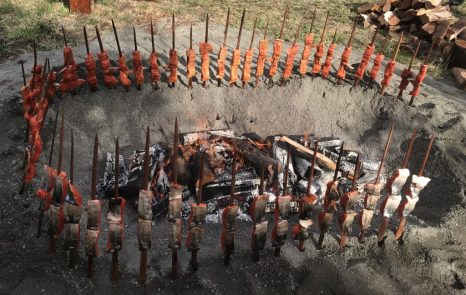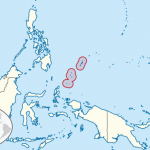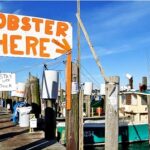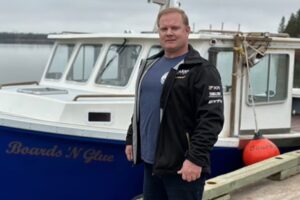Tag Archives: Klamath River
Hundreds of thousands of salmon released in Northern California river die in ‘large mortality’ event
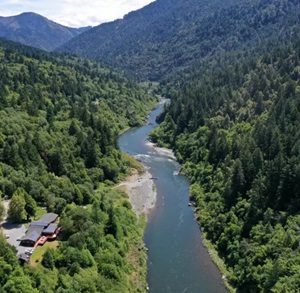 As many as hundreds of thousands of fall-run Chinook salmon died early last week due to suspected gas bubble disease. The fish were released into the 257-mile-long Klamath River near the California-Oregon border following November’s historic dam removal at the site, which was intended to help the stream flow freely again and bolster the habitat for the protected species. Still, the CDFW said those conditions, while unfortunate, were anticipated, and that its hatchery has over three million more salmon it plans to release later this month, downstream from the dam and tunnel. Juvenile fish like salmon fry can have high mortality rates due to predators, lack of food or disease, and the CDFW’s planned release will include fish in later stages of the species’ life cycle, specifically smolts and yearlings. more, >>click to read<< 09:28
As many as hundreds of thousands of fall-run Chinook salmon died early last week due to suspected gas bubble disease. The fish were released into the 257-mile-long Klamath River near the California-Oregon border following November’s historic dam removal at the site, which was intended to help the stream flow freely again and bolster the habitat for the protected species. Still, the CDFW said those conditions, while unfortunate, were anticipated, and that its hatchery has over three million more salmon it plans to release later this month, downstream from the dam and tunnel. Juvenile fish like salmon fry can have high mortality rates due to predators, lack of food or disease, and the CDFW’s planned release will include fish in later stages of the species’ life cycle, specifically smolts and yearlings. more, >>click to read<< 09:28

CDFW INVESTS $17.5 MILLION IN THE KLAMATH BASIN
The California Department of Fish and Wildlife recently provided $17.5 million for the collaborative planning and implementation of three emergency projects that aim to restore critical salmon habitat, improve water management and make the Klamath Basin more resilient to climate change. “I would like to thank California Governor Gavin Newsom and Department of Fish and Wildlife Director Charlton Bonham for supporting our efforts to rebuild salmon runs on the Klamath River and its tributaries,” said Yurok Vice Chairman Frankie Myers. “I also want to acknowledge the diverse group of stakeholders working on these projects. Together, we are carving out a new path toward restoration in the Klamath Basin.” >click to read< 09:25
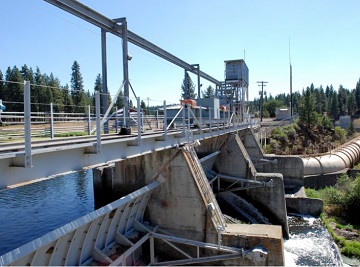
US regulators to vote on removal of four dams on lower Klamath River
The largest dam demolition and river restoration plan in the world could be close to reality Thursday as U.S. regulators vote on a plan to remove four aging hydro-electric structures, reopening hundreds of miles of California river habitat to imperiled salmon. The vote by the Federal Energy Regulatory Commission on the lower Klamath River dams is the last major regulatory hurdle and the biggest milestone facing a $500 million demolition proposal championed by Native American tribes and environmentalists for years. But plans to remove the dams have been controversial. “The whole question is, will this add to the increased production of salmon? It has everything to do with what’s going on in the ocean (and) we think this will turn out to be a futile effort,” >click to read< 11:10

Warming rivers in US West killing fish, imperiling industry
Salmon fisherman Mike Hudson sits on the bow of his boat at the Berkeley, Calif., Marina on Thursday, July 22, 2021. Baby salmon are dying by the thousands in one river and an entire run of endangered salmon could be wiped out in another. The plummeting catch has led to skyrocketing retail prices for salmon, hurting customers who say they can no longer afford the $35 per pound of fish, said Hudson, who has spent the last 25 years catching and selling salmon at farmers’ markets in Berkeley. “An extreme set of cascading climate events is pushing us into this crisis situation,” said Jordan Traverso, a spokeswoman for the California Department of Wildlife and Fish. 14 photos, >click to read< 10:03
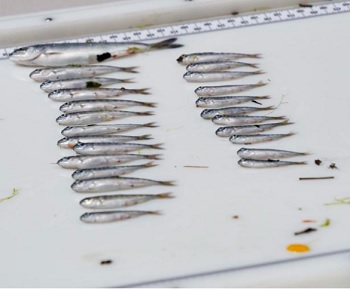
Serious fish kill consumes the Klamath River
As it enters the Yurok Reservation, the Lower Klamath River is as picturesque as it gets. Clear water rushes over gentle rapids, framed by verdant hills and a cerulean sky. An untrained eye would never notice the devastation beneath the surface — save for the tiny fish floating lifeless in the water. Over the past several weeks, an outbreak of the parasite Ceratonova shasta has ripped through young salmon throughout the lower reaches of the Klamath watershed. Driven by high temperatures and low flows out of Iron Gate Dam, the disease is resulting in what the Yurok Tribe is calling a “catastrophic” fish kill. photos, >click to read< 09:36
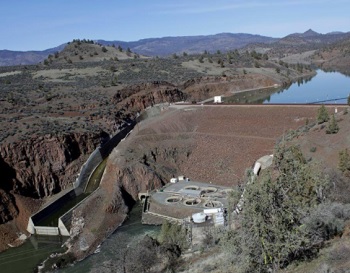
Plan will remove Klamath River dams, reopening the waterway along Oregon-California border
An agreement announced Tuesday paves the way for the largest dam demolition in U.S. history, a project that promises to reopen hundreds of miles of waterway along the Oregon-California border to salmon that are critical to tribes but have dwindled to almost nothing in recent years. If approved, the deal would revive plans to remove four massive hydroelectric dams on the lower Klamath River, creating the foundation for the most ambitious salmon restoration effort in history. >click to read< 12:16

Sick River: Can These California Tribes Beat Heroin and History?
For thousands of years, the Klamath River has been a source of nourishment for the Northern California tribes that live on its banks. Its fish fed dozens of Indian villages along its winding path, and its waters cleansed their spirits, as promised in their creation stories. But now a crisis of opioid addiction is gripping this remote region. At the same time, the Klamath’s once-abundant salmon runs have declined to historic lows, the culmination of 100 years of development and dam building along the river. Today, many members of the Yurok, Karuk and Hoopa tribes living in this densely forested area south of the California-Oregon border see a connection between the river’s struggle and their own. >click to read<16:01
Trump official says government won’t stand in the way of removing Klamath dams
 After the Obama administration helped broker a deal last year to tear down four dams straddling the California-Oregon border, practically everyone involved figured President Donald Trump would undermine it. They assumed Trump would side with conservative activists and Republican congressmen who thwarted an earlier version of the same agreement in 2015. Those assumptions are proving wrong. The fight over the Klamath River is one of country’s fiercest, longest-running water wars. click here to read the story 08:26
After the Obama administration helped broker a deal last year to tear down four dams straddling the California-Oregon border, practically everyone involved figured President Donald Trump would undermine it. They assumed Trump would side with conservative activists and Republican congressmen who thwarted an earlier version of the same agreement in 2015. Those assumptions are proving wrong. The fight over the Klamath River is one of country’s fiercest, longest-running water wars. click here to read the story 08:26
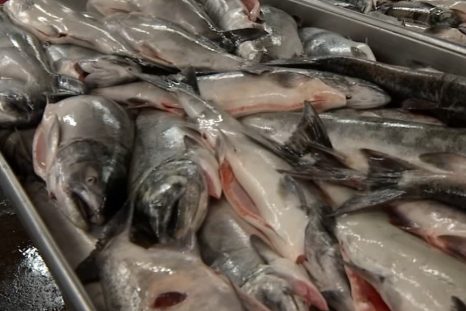
Limited salmon numbers, sea lion population making tough season for fishermen
Governor Brown, along with Governor Jerry Brown of California, recently submitted a request to U.S. Commerce Secretary Wilbur Ross for a declaration of a “catastrophic regional fishery disaster,” and a commercial fishery failure. The request comes after the National Marine Fisheries Service closed the southern half of the Oregon coast to commercial salmon fishing to protect dwindling stocks of Chinook salmon on the Klamath River. “When you look at the Klamath situation, it affects fisheries all up and down the coast,” said Steve Fick, who owns Fishhawk Fisheries in Astoria. Executive Director of the Port of Astoria Jim Knight said the south coast closure will likely mean more fishing boats competing for limited numbers of salmon on the north coast. click here to read the story 08:09
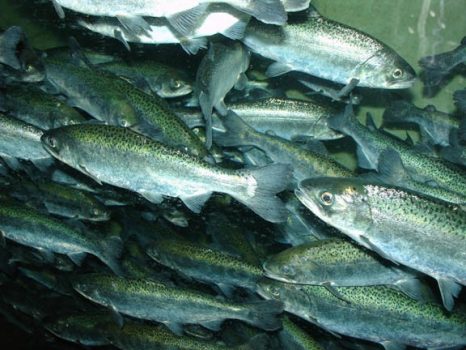
In ‘Crisis,’ Yuroks Suspend Commercial Salmon Season
For the second year in a row, the Yurok Tribe will not have a commercial fishery — a devastating blow to the tribe’s culture and economy. “We are in crisis mode,” said Yurok Tribal Chair Thomas O’Rourke in a press release that lamented poor conditions on the Klamath River that have led to historically low salmon returns. “The Klamath is our grocery store, our church and our main highway. It’s our lifeline. We will leave no stone unturned in search of additional short-term and long-term solutions to address the most terrible fisheries disaster in the Tribe’s history.” The release comes after the Pacific Fisheries Management Council released its predicted Chinook salmon returns for 2017 at 11,000 fish — the lowest on record — and the tribe’s fish harvest allocation at 650 fish, or one for every 10 tribal members. The predicted return comes after two years of disease outbreaks in juvenile fish due to low flows and elevated water temperatures in the Klamath River. continue reading the story here 13:44
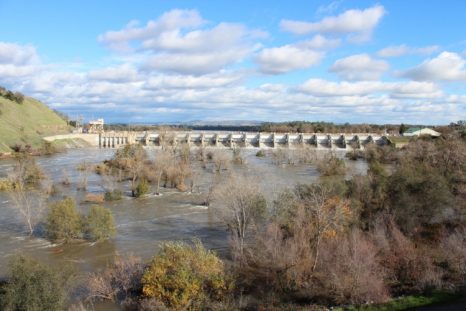
Low Numbers of Sacramento and Klamath River Salmon Point to Poor Season
Recreational and commercial fishermen attending the annual salmon fishery information meeting in Santa Rosa on March 1 received grim news from state and federal biologists – they will see reduced salmon fishing opportunities in both the ocean and the Sacramento and Klamath River systems, due to low returns of spawning fish to the rivers last fall. The pre-season numbers unveiled by Dr. Michael O’Farrell of the National Marine Fisheries Service estimate only 230,700 Sacramento River fall run Chinook adults and 54,200 Klamath River fall run adults will be in the ocean this year. Biologists noted that both forecasts are lower than those of recent years, with the forecast for Klamath fall run being among the lowest on record. Salmon originating from these river systems typically comprise the majority of salmon caught in the state’s ocean and inland fisheries. Ocean regulatory management for salmon fisheries on the ocean from Cape Falcon in Oregon to the Mexico-US Border is heavily based on these runs. continue reading the article by Dan Bacher here 11:22
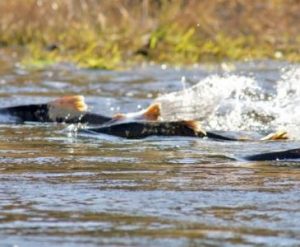
Feds Facing Order to Redirect Klamath River Water for Salmon
Two Native American tribes sued the U.S. Bureau of Reclamation last year, claiming its bungled management of Klamath River waterways allowed a deadly parasite to infect 91 percent of endangered juvenile Coho and Chinook salmon. The Yurok and Hoopa Valley Tribes say they depend on the salmon for subsistence, income and for traditional ceremonies that define their people. Lawyers for the federal government and an industry group of farmers and ranchers argue that diverting water to help salmon will harm businesses that support local jobs and communities and threaten another set of endangered fish, the shortnose sucker and Lost River sucker. In separate complaints against the federal government, the tribes say infection rates caused by the deadly parasite C. shasta, should have required the bureau to review its Klamath Irrigation Project’s impact on threatened salmon two years ago, but the bureau failed to take action in violation of the Endangered Species Act.During a hearing Friday, U.S. District Judge William Orrick III agreed the bureau should have reviewed the project when infection rates climbed to 81 percent in 2014 and 91 percent in 2015, well beyond the maximum 49 percent estimated in a 2013 biological opinion issued by co-defendant National Marine Fisheries Service. Read the story here 16:47
Yurok Tribe finds deadly disease in Klamath River salmon
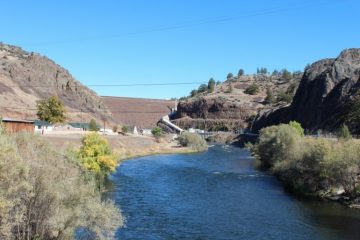 Dan Bacher: The Klamath River salmon fishery, an integral part of the culture, religion and livelihoods of the Yurok, Hoopa Valley and Karuk Tribes of Northern California, is going through some tough times this year. Because of the record-low run of fall-run Chinook salmon projected by federal fishery managers earlier this year, the Yurok Tribe, the largest Indian Tribe in California, held its Klamath Salmon Festival this August without serving traditionally-cooked salmon to the public as it has done for 54 years. Then on August 19, the Tribe announced that Yurok Fisheries crews conducting routine fish disease monitoring have found that salmon in the Klamath River on the Yurok Reservation are infected with a potentially deadly disease. Ichthyophthirius multifiliis, commonly known as ich (pronounced “ick”), is capable of causing large fish kill events, according to the Tribe. Ich was the primary pathogen that caused the 2002 fish kill in the Klamath River and killed more than 35,000 adult Chinook salmon and steelhead after the disease spread in low, warm conditions spurred by Bush administration water policies that favored irrigators over fish and downstream water users. Read the story here 19:22
Dan Bacher: The Klamath River salmon fishery, an integral part of the culture, religion and livelihoods of the Yurok, Hoopa Valley and Karuk Tribes of Northern California, is going through some tough times this year. Because of the record-low run of fall-run Chinook salmon projected by federal fishery managers earlier this year, the Yurok Tribe, the largest Indian Tribe in California, held its Klamath Salmon Festival this August without serving traditionally-cooked salmon to the public as it has done for 54 years. Then on August 19, the Tribe announced that Yurok Fisheries crews conducting routine fish disease monitoring have found that salmon in the Klamath River on the Yurok Reservation are infected with a potentially deadly disease. Ichthyophthirius multifiliis, commonly known as ich (pronounced “ick”), is capable of causing large fish kill events, according to the Tribe. Ich was the primary pathogen that caused the 2002 fish kill in the Klamath River and killed more than 35,000 adult Chinook salmon and steelhead after the disease spread in low, warm conditions spurred by Bush administration water policies that favored irrigators over fish and downstream water users. Read the story here 19:22
Yurok Tribe Files Intent to Sue National Marine Fisheries Service and the Bureau of Reclamation
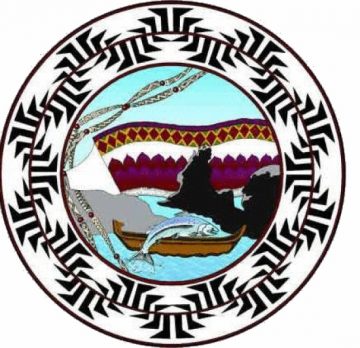 In response to massive fish disease outbreaks in back-to-back years on the Klamath River, the Yurok Tribe submitted a 60-day notice of intent to sue the National Marine Fisheries Service and the Bureau of Reclamation. “We cannot stand by and do nothing while our salmon hover over the brink of extinction,” said Thomas P. O’Rourke Sr., Chairman of the Yurok Tribe. “We will not continue to watch water managers jeopardize the fate of our fish and our river.” 91 percent of the juvenile, Klamath salmon were infected with a deadly parasite in 2015, as were a nearly identical number of fish in 2014. Given the nearly 100 percent mortality rate associated with the disease, approximately 90 percent of the Chinook salmon and likely an equal quantity of coho died in the main-stem Klamath River during those years, according to the notice. This year’s predicted adult salmon run is one of the lowest on record, which forced the Yurok Tribe to make a difficult decision to completely forgo all commercial fishing in 2016. Read the rest here 15:22
In response to massive fish disease outbreaks in back-to-back years on the Klamath River, the Yurok Tribe submitted a 60-day notice of intent to sue the National Marine Fisheries Service and the Bureau of Reclamation. “We cannot stand by and do nothing while our salmon hover over the brink of extinction,” said Thomas P. O’Rourke Sr., Chairman of the Yurok Tribe. “We will not continue to watch water managers jeopardize the fate of our fish and our river.” 91 percent of the juvenile, Klamath salmon were infected with a deadly parasite in 2015, as were a nearly identical number of fish in 2014. Given the nearly 100 percent mortality rate associated with the disease, approximately 90 percent of the Chinook salmon and likely an equal quantity of coho died in the main-stem Klamath River during those years, according to the notice. This year’s predicted adult salmon run is one of the lowest on record, which forced the Yurok Tribe to make a difficult decision to completely forgo all commercial fishing in 2016. Read the rest here 15:22
Feds release extra water to save Klamath salmon from disease
 With water scarce in Northern California’s Klamath Basin, a federal agency is again releasing cool, clean water into the Klamath River to prevent a repeat of the 2002 fish kill that left tens of thousands of adult salmon dead.The U.S. Bureau of Reclamation said releases started Friday from Lewiston Dam on the Trinity River, the Klamath’s primary tributary, and would continue into late September. Similar releases were done the last three years. They come from water that is shared with farms in the Central Valley. “In this fourth year of severe drought,,, Read the rest here 19:54
With water scarce in Northern California’s Klamath Basin, a federal agency is again releasing cool, clean water into the Klamath River to prevent a repeat of the 2002 fish kill that left tens of thousands of adult salmon dead.The U.S. Bureau of Reclamation said releases started Friday from Lewiston Dam on the Trinity River, the Klamath’s primary tributary, and would continue into late September. Similar releases were done the last three years. They come from water that is shared with farms in the Central Valley. “In this fourth year of severe drought,,, Read the rest here 19:54
Keeping the Klamath safe for salmon
A federal agency, under pressure to supply water to irrigators, diverts a North Coast river, creating a killing field for tens of thousands of chinook salmon and other fish. Sound familiar? It’s the Cliff’s Notes version of events 11 years ago on the Klamath River — an unnatural disaster with disastrous consequences for coastal communities and Indian tribes that rely on salmon fisheries for their livelihoods. more@pressdemocrat 10:34
Feds recommend removing dams from Klamath River – leaving office, Interior Secretary Ken Salazar called on Congress to take action
GRANTS PASS, Ore. — The federal government on Thursday recommended that all four aging hydroelectric dams be removed from the Klamath River in southern Oregon and Northern California to help struggling wild salmon runs, and nearly $1 billion should be spent on environmental restoration. continued







